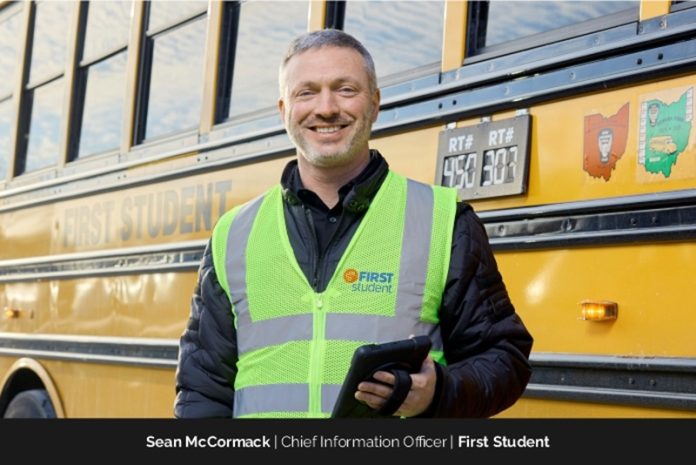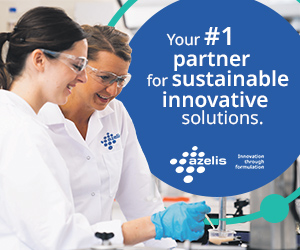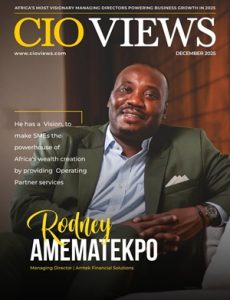Technology is often seen as a tool for improving efficiency or minimizing business costs, but for Sean McCormack, it is much more than that. It is a means to make a real difference in the world. As Chief Information Officer at First Student, Sean is spearheading a digital transformation that is revolutionizing student transportation. He is showing that innovation is not just about making operations efficient, it is also about providing unmatched care and safety for students. His initiatives are enabling First Student to deliver an exceptional transportation experience to students, parents, and employees.
“We’re not just transforming First Student, we’re setting a new standard for the future of student transportation,” Sean says.
Career Path: From Military Intelligence to IT and Digital Innovation
Sean began his career in the armed forces, serving 8 years in military intelligence. One of his assignments was teaching Arabic at the Air Force Academy. At the time, language learning was entirely in-person. This method was not only expensive but also inefficient. Sean recalls that a faculty member, Lt. Colonel Sutherland, had the idea to teach languages via computers. “It was something unheard of at the time,” he points out.
Sean was soon recruited to help build the software. Though none of the team had strong tech backgrounds, they managed to create the first computer-based language training system. This caught the attention of agencies like the FBI, CIA, and NSA, and they ended up publishing training materials in multiple languages, including several commercial offerings. This experience made Sean realize that technology could revolutionize industries and drive innovation.
After leaving the military, he continued down the path of innovation, working with startups and then with Fortune 500 companies, including MillerCoors, Harley-Davidson, Grainger, and now First Student. “It all traces back to that early moment where technology changed the way we approached learning,” Sean says.
Impact of Three Mentors
Over the years, Sean has learned from a number of people. However, three mentors, in particular, have had a “big impact” on his career. One of them is Lt. Col. Sutherland, who came up with the idea to teach languages via computers. He taught Sean that all it takes to make an impact is a crazy idea and a belief that one can bring that idea to life. “That mindset has shaped how I approach challenges and innovation,” he shares.
The second mentor that Sean talks about is Amy Bernstein, the former Vice President of Global Thought Leadership at ManpowerGroup. She showed him the power of storytelling and how to communicate effectively as a business-facing executive. “Before I met her, I spoke ‘tech’,” Sean says. “She taught me how to speak ‘business,’ which was a huge booster for my career.” He believes this is what differentiates him from a lot of other CIOs.
Dave Cotteleer, the former CIO at Harley-Davidson, also had an influence on Sean as a mentor. He taught him the value of being an authentic leader and how to balance delivering results with integrity and genuinely caring for one’s team. Sean shares that Dave’s guidance reinforced that strong leadership is about more than just business outcomes; it is about people.
“Each of them played a crucial role in shaping the way I lead, communicate, and drive impact in my current role as CIO,” he adds.
Two Pivotal Moments
Two key moments have significantly shaped Sean’s journey as a CIO. The first was at an eCommerce startup, where he was tasked with building a custom platform to support rapid growth. He says that to succeed, he immersed himself in every part of the business, from the warehouse to finance – learning how it all worked. “This experience,” Sean says, “taught me the importance of understanding the business before solving problems with technology.”
The second moment was at Harley-Davidson, where he served as Chief Technology Officer and Head of Digital. There, he founded the Digital Innovation group. “While developing a connected vehicle app, we learned through user testing that the real needs of riders were different from internal assumptions,” Sean recalls. He explains that riders wanted a mobile app that focused on scenic routes and ride planning, not just a dealership locator and list of events. This user-driven design approach reshaped their strategy and led to the success of the app, which still holds a 4.8-star rating. Sean says this experience reinforced the power of focusing on user needs in digital product development.
Dealing with Challenges
For Sean, transitioning from the military, where teams felt like family, to civilian life was a tough adjustment. He remembers a challenging period early in his career when he was laid off after a startup he worked for was sold. “Both my wife and I were let go with little notice,” he says.
Later, during the Great Recession, he had to make difficult cost-cutting decisions, which challenged him to reevaluate his priorities as a leader. As a result, he now values lean operations and investing in people, ensuring they feel valued and prepared for any situation. Sean has also always found internal politics counterproductive so he focuses on building strong relationships with everyone he works with. He says, “I try to proactively identify and address any political issues before they can escalate into real problems.”
The Journey with First Student
Sean joined First Student, a provider of school bus services, in January 2022. “When I first encountered First Student, I was inspired by the company’s noble mission and strong commitment to innovation,” he says. He was also drawn to its focus on improving the student transportation experience, and the challenge of transforming a large, established organization.
“What really stood out to me was First Student’s deep-rooted values of safety, reliability, and efficiency,” Sean says, “and how those values aligned with my own leadership principles.” He has always been passionate about leveraging technology to make a meaningful difference.
In his previous roles, he witnessed how technology can be an enabler, driving operational efficiency, improving employee engagement, and enhancing customer experiences. Now, in his current role, he finds the opportunity to lead the digital transformation at First Student, particularly with the development and rollout of HALO™, to be an exciting challenge.
“In the military and startup worlds, I learned the importance of scaling teams, staying efficient, and standardizing core capabilities,” Sean says. “First Student’s emphasis on making work easier for employees and continuously improving performance resonated with me.”
“Also, it’s not just about deploying new technology, it’s about using it to empower people and improve their lives, which aligns perfectly with my approach to leadership,” he adds.
Series of Transformative Initiatives
Since joining First Student, Sean has led several transformative initiatives. The launch of FirstAlt is one of the most rewarding experiences for him. This service offers safe, reliable transportation for students with special needs, homelessness, and other hard-to-serve trips, using custom software designed specifically for these unique challenges.
FirstAlt has quickly exceeded expectations, expanding across 13 states and earning industry praise for its impact on efficiency, safety, and customer satisfaction. “It’s been amazing to see how this innovation is creating real, tangible benefits for school districts and families,” Sean says.
Another key achievement has been their push toward EV adoption and the deployment of AI-powered safety cameras. Sean explains that these advancements are helping them improve safety, reduce emissions, and provide a higher level of service to the communities they serve. And most recently, Sean and his team launched HALO, a technology platform integrating every aspect of student transportation operations, which has revolutionized how they manage operations and improved everything from fleet tracking to driver performance.
“I’m here to drive improvements and foster innovation so we can continue making strides toward delivering the best possible experience for students, parents, and employees,” Sean says.
Views on Success
As CIO, Sean believes success is about finding ways to simultaneously increase revenue, reduce costs, and maximize overall company value — all by leveraging technology to make a real difference in the world. “With our recent launch of HALO, we’ve made significant strides in this direction,” he says.
Personally, for Sean, success is when the technology makes work easier for employees, helps their customers – parents, kids, and districts – feel safer and more connected, and allows them to continue innovating to keep raising the bar. “If we can continue to lead with cutting-edge technology and create impactful outcomes for students, families, and employees, I see that as a major success,” he says. “We’re already making tremendous progress, and HALO is a central part of that transformation.”
Vision for First Student
Sean wants First Student to continue leading the industry in technology and innovation. He believes that digital advancements should not only improve overall business performance but also create new revenue opportunities and elevate the experiences of both their customers and employees. According to him, their above-ground charging infrastructure solution, First Charge, is a “perfect example” of how they are pushing the boundaries, leveraging cutting-edge solutions, to enhance safety, efficiency, and operational excellence.
“My goal is to see First Student recognized as an innovation leader, setting a benchmark both within and beyond our industry,” Sean says.
Not-So-Typical Day at Work
Sean does not follow a set routine at work. He says, “There really is no ‘typical’ day!” He explains that the challenge of any senior leadership role is being able to shift rapidly between tactical operations and large strategic discussions. For example, he could start his day handling an urgent operational issue, then move into a team coffee chat to boost employee engagement, followed by a leadership webinar on a new initiative.
“Next, I might jump into a vendor negotiation, have several one-on-ones, participate in an executive steering committee, review a business case, demo a new innovation proof of concept, and wrap up with a team-related matter,” Sean says. For him, the key is constantly adjusting between high-level strategy and the finer details of operations, ensuring everything is running smoothly.
And Sean strives to balance innovation, execution, and communication to keep his team, peers, and the broader organization aligned on priorities and progress. “It’s all about being agile and adaptable,” he says.
As Sean has a demanding, not-a-typical schedule, how does he maintain a work-life balance? According to him, maintaining a work-life balance comes down to a few key principles. In the military, he learned the importance of sleep and exercise to manage stress and stay physically fit. He has made exercise a “non-negotiable” part of his routine. When he was working in the startup world, he realized that working excessive hours is unsustainable — he tries to focus on a productive, balanced and sustainable pace. “I minimize distractions and maximize my time at work and balance it with a vibrant life outside of work,” Sean says.
He recharges with activities like martial arts, dance classes with his wife, coding with his daughter, and learning new languages.
The Leadership Style
Over the years, Sean’s leadership style has evolved to become more strategic and communicative. He has also become a stronger advocate for his team. Over his career, Sean has become more attuned to the real impact of change on people – both positive and negative.
“Understanding and addressing these human factors has become a critical part of how I drive transformation and innovation,” Sean says.
Giving Back and Mentoring
Sean and his family are “deeply committed” to giving back through volunteering and philanthropy. They support various non-profit organizations. Sean also finds great fulfillment in mentoring individuals, and helping them navigate their careers and personal growth. “Being able to make a positive impact like the impact my mentors left on me beyond my professional work is something I truly value,” he says.
Inspiring Future Generations
Sean believes that any work that improves people’s lives, no matter how big or small, leaves a lasting impact. Whether it is enabling someone to learn a language from the comfort of their home, helping motorcycle riders create memorable and safe experiences, or enhancing the safety of children and drivers on school buses, each of these innovations contributes to shaping a better future, according to him.
He also points out that when they improve safety and experiences, they not only advance technology but also positively influence the way people live, work, and interact with the world around them. “This kind of work,” Sean says, “will continue to inspire future generations to think about how technology can be used to solve real-world problems and make a difference in people’s lives.”
Advice to Aspiring Leaders
In his advice to aspiring leaders in information technology, Sean underscores the importance of understanding the business they are serving. “Technology must align with its goals,” he points out. He encourages them to build strong relationships with colleagues and prioritize the user, ensuring their solutions meet their needs.
He also advises aspiring leaders to balance innovation with operational excellence and master soft skills like communication and emotional intelligence, as the only way to drive progress is through people. Sean recommends becoming financially savvy – understanding budgets, business cases, and key financial concepts.
“Finally, maintain work-life balance,” Sean says. “As stress increases with responsibility, finding new ways to recharge is crucial to avoid burnout.”





